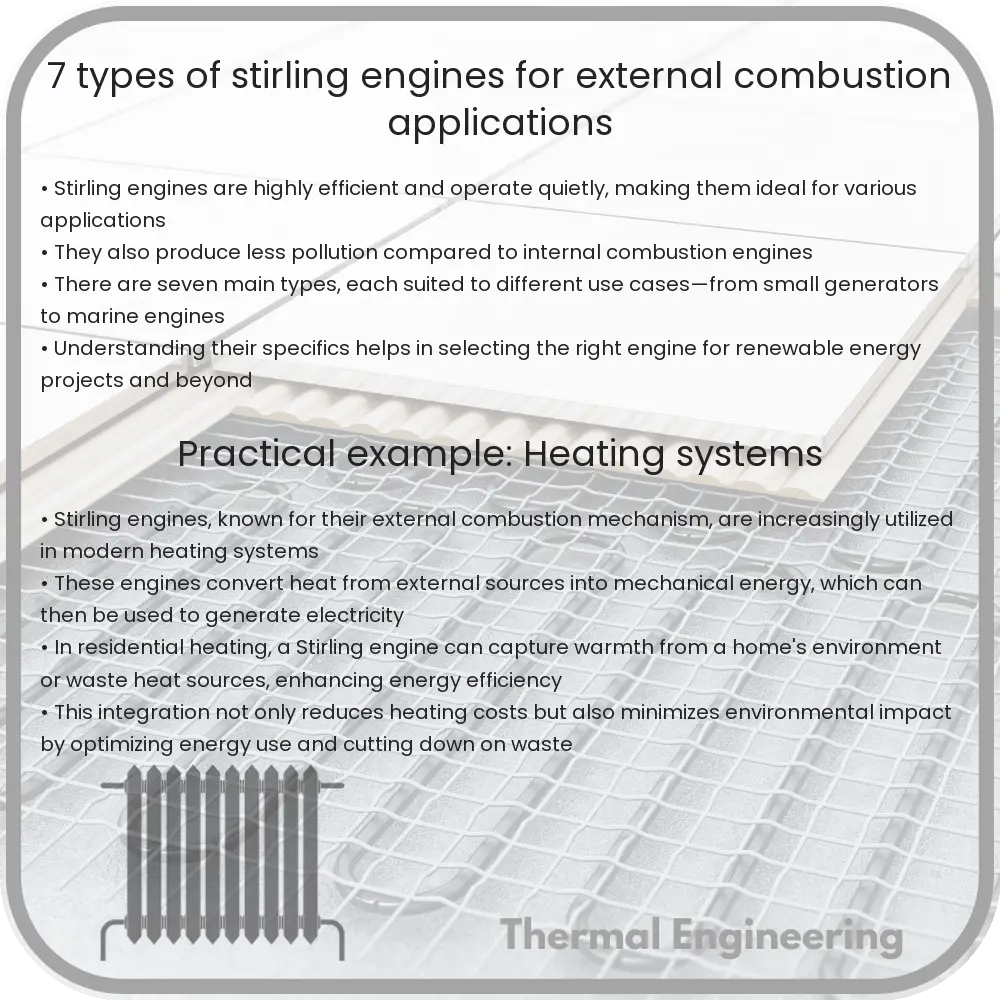Learn about the Stirling engine, an efficient external combustion engine utilizing different heat sources for power.

Understanding Stirling Engines: 7 Types for External Combustion Applications
The Stirling engine, named after Robert Stirling who invented it in 1816, is a type of external combustion engine. Unlike internal combustion engines where the fuel combustion happens inside the engine itself, Stirling engines feature combustion occurring outside of the engine, which brings about various advantages including greater efficiency, quieter operation, and the ability to use multiple types of heat sources. These engines operate on the Stirling cycle, which involves cyclic compression and expansion of air or other gas at different temperature levels, thereby converting thermal energy into mechanical power.
There are numerous designs and configurations of Stirling engines, adapted for different applications and power needs. Here we explore seven popular types of Stirling engines:
- Alpha Stirling Engine
This type has two separate power pistons in separate cylinders, one hot and one cold. The hot cylinder is situated at the heat source, whereas the cold one is situated at the cooling source. The transfer of gas between the cylinders drives the pistons and generates mechanical power. This design generally offers high power output and efficiency.
- Beta Stirling Engine
The Beta configuration utilizes a single cylinder with a hot end and a cold end. It features a piston-displacer that moves the working gas between the heated and cooled areas of the cylinder. The same cylinder houses a power piston integrated directly into the displacer, or at least connected closely to it, which helps in simplifying the design and improving responsiveness.
- Gamma Stirling Engine
The Gamma type is a variation of the Beta where the power piston and the displacer are in separate but connected cylinders. This arrangement allows for greater flexibility in design and can be easier to build, while still maintaining good efficiency and power output.
- Free-Piston Stirling Engine
This variant does not use a conventional crankshaft. Instead, it relies on the movement of one or more pistons that are designed to be dynamically balanced. The movement can be used directly to generate power or to drive a linear generator for electrical power production. Free-piston Stirling engines are particularly noted for their smooth operation and high efficiency.
- Ringbom Stirling Engine
Named after the engineer who developed it, the Ringbom Stirling engine eliminates the need for a mechanical linkage (such as a crankshaft) to operate the displacer. Instead, it uses a configuration where the displacer is driven by differences in pressure or thermal expansion mechanisms, simplifying the overall design and reducing maintenance needs.
- Rotary Stirling Engine
Unlike traditional piston-based designs, rotary Stirling engines operate using a rotary displacer. This development allows the engine to potentially reduce mechanical complexity and wear while proving easy to integrate into applications where a compact and robust engine is beneficial.
- Fluidyne Stirling Engine
This type of engine combines Stirling cycle with a liquid pump. The most common fluid used is water. Fluidyne engines have an advantage in simplicity and low-cost materials and are easy to build, making them an excellent choice for low-power applications and educational purposes.
Each type of Stirling engine presents a unique set of characteristics tailored to different applications, ranging from solar power generation to underwater power systems and even space propulsion. The adaptability in fuel sources—from solar to geothermal and biofuels—makes Stirling engines a versatile and environmentally friendly option in today’s diverse energy landscape. Understanding the types and applications of Stirling engines can be fundamental for engineers and innovators looking to harness alternative energy sources effectively.